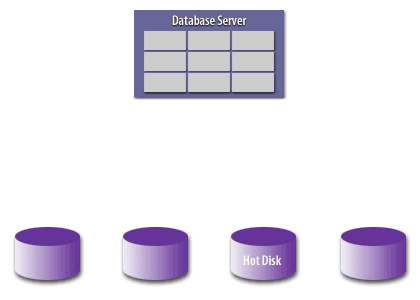| Lesson 3 | Iostat and hot disks |
| Objective | Define a hot disk. |
Define hot disk
The Oracle DBA always tries to minimize disk I/O. A good way to do this is to move data files that map to hot or busy disks to
disks that have less activity. Those of you may remember disk architecture from your college courses will remember that there are three sources in disk delay. There's the seek delay which is the movement of the read write heads between the cylinders in order to get the information that you want, the rotational delay as the platter spins in order to get the information, and the final component which is the data transmission time for the information back to the Oracle instance. However, when dealing with the Oracle database we have to remember that we may have many dozens, if not hundreds of disk devices attached to our instance. In these cases disk load balancing is very important because we don't want see any single disk become hot. By hot, we mean any dik that has a disproportional amount of I/O on its relative to the other disks in your database.
Hot disks
A hot disk is one with a disproportional amount of I/O compared to the other disks.
Hot disks may be unavoidable, especially if you have large physical disks. For example, consider a 70 gigabyte database that resides on two 35 gigabyte disks. It is quite likely that each of the two disks will always be busy, or hot.
Hot disks vs. bottlenecks
In severe cases, hot disks may become overloaded and disk bottlenecks may appear. A bottleneck occurs when tasks queue up waiting to access data on a single physical disk, and the I/O rate is above the published I/O maximum for your physical disk. A file with high I/O does not always constitute a bottleneck. It is okay for a disk to be busy, if there are not tasks in queue, waiting to access the disk.
Tracking and identifying Hot Disks
By tracking the disk I/O, and storing the iostat data into an Oracle table, you can write a SQL statement against this table to easily identify hot disks.
Note: Remember that disk I/O is very sporadic and changes constantly. You may see a completely different I/O signature at 10 a.m. than at 2 p.m. The best way to balance I/O across your disks is to measure I/O over a 24-hour period.
A hot disk in Oracle refers to a disk in a storage array that is working at high utilization. The purpose of the hot disk is to identify potential performance bottlenecks, allowing administrators to take proactive measures to optimize storage performance and ensure continued availability of the database. The next lesson is about identifying the specific data files that may cause problems due to high levels of activity.
Note: Remember that disk I/O is very sporadic and changes constantly. You may see a completely different I/O signature at 10 a.m. than at 2 p.m. The best way to balance I/O across your disks is to measure I/O over a 24-hour period.
A hot disk in Oracle refers to a disk in a storage array that is working at high utilization. The purpose of the hot disk is to identify potential performance bottlenecks, allowing administrators to take proactive measures to optimize storage performance and ensure continued availability of the database. The next lesson is about identifying the specific data files that may cause problems due to high levels of activity.